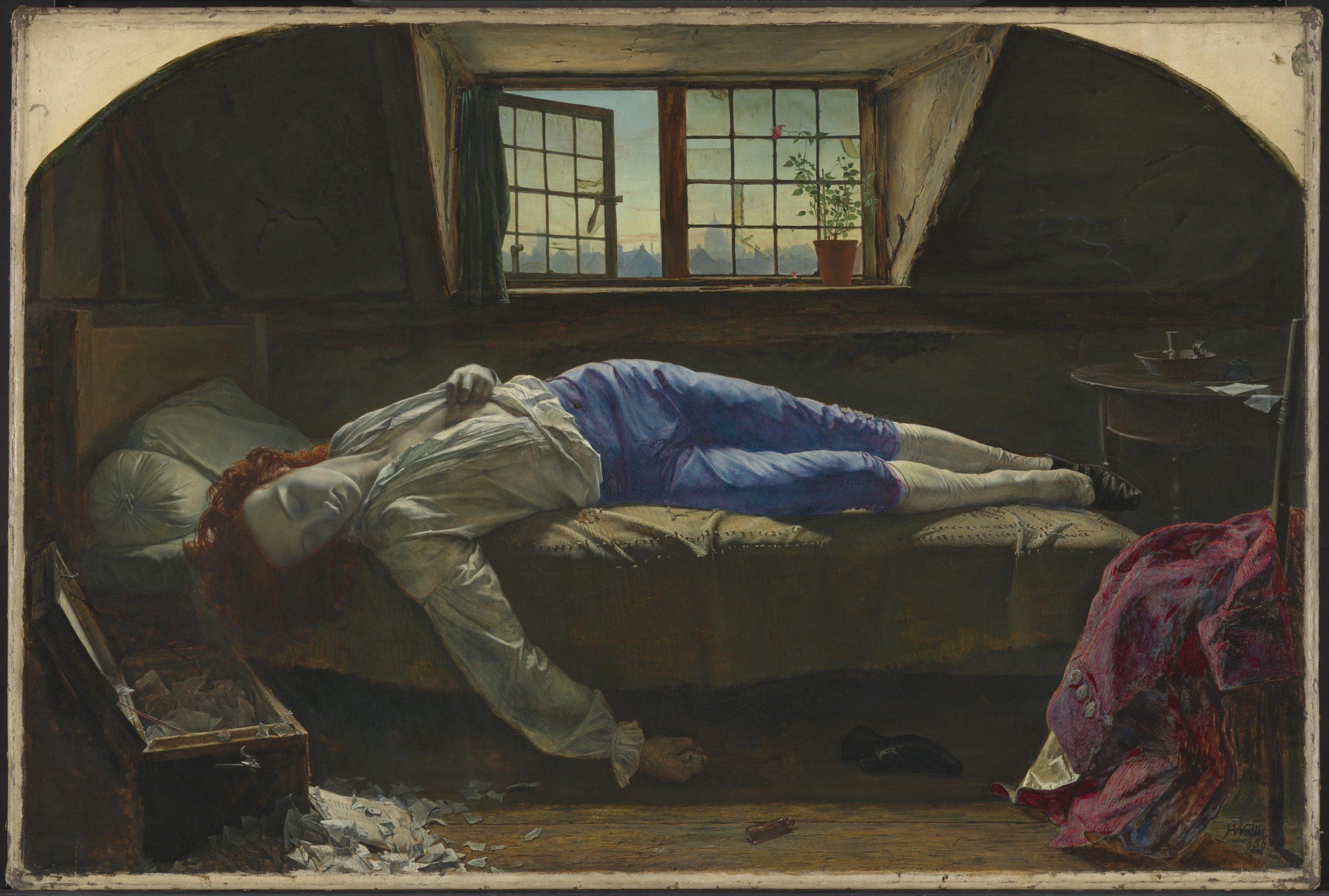My Favourite Painting: Christopher Jackson
The poet and artist Christopher Jackson chooses 'a macabre picture, with marvellous details': Chatterton by Henry Wallis.


Christopher Jackson on his choice, Chatterton by Henry Wallis
‘Poor Chatterton. This is not only a wonderful picture, but a lesson to artists. Try not to die in a garret. In the wake of lockdown, the image of isolation seems pertinent. Outside of poetry and painting, my work now is helping young people with their careers. I never pass this painting without thinking on the virtues of compromise in life. It’s a macabre picture, with marvellous details: the expensive-looking trousers, especially. It has a tranquil sympathy that tells us that other options were available. The hero of the picture isn’t Chatterton; it’s the pot of flowers on the windowsill.’
Christopher Jackson is a poet, artist and member of the Finito Education management team. His latest book of poetry, An Equal Light, is out now.
Charlotte Mullins on Chatterton
A red-headed man lies lifeless on a narrow bed, his arm grazing the floor, a phial of poison nearby. His right shoe has tumbled to the ground, but the rest of his body is clothed, his breeches glowing in the last of the day’s light. There is no money for a candle, no rug and the paint is peeling. The attic room’s small window is open and London’s skyline can be seen in the yellowing light. A fragile pot plant outlives the young man, its single bloom tender on a fragile stem, and his poetry lies in shreds across the floor.
Henry Wallis painted the 18th-century poet Thomas Chatterton in 1856, exhibiting the painting at the Royal Academy to great acclaim. It was the holy grail of a Pre-Raphaelite painting, one that was true to Nature both in how it captured the scene and in how it conveyed emotion. The room was a re-creation of Chatterton’s Brook Street attic, where he killed himself by drinking arsenic aged 17. No surviving portraits of Chatterton exist, so Wallis had free rein to conjure a ‘likeness’ that simultaneously conveyed the poet’s melancholy, his emaciated body and his romantic appeal as a doomed hero.
Wallis used novelist George Meredith as his model. His flame-red hair contrasts with his waxy white skin and blue breeches. These are the colours of British identity, of the Union Flag. The painting offered a sideswipe at the then government and its lack of support for young artists, by suggesting that the country was culpable for this death.
Sign up for the Country Life Newsletter
Exquisite houses, the beauty of Nature, and how to get the most from your life, straight to your inbox.

Charlotte Mullins is an art critic, writer and broadcaster. Her latest book, The Art Isles: A 15,000 year story of art in the British Isles, will be published by Yale University Press in October 2025.
-
 'Monolithic, multi-layered and quite, quite magnificent. This was love at first bite': Tom Parker Bowles on his lifelong love affair with lasagne
'Monolithic, multi-layered and quite, quite magnificent. This was love at first bite': Tom Parker Bowles on his lifelong love affair with lasagneAn upwardly mobile spaghetti Bolognese, lasagne al forno, with oozing béchamel and layered meaty magnificence, is a bona fide comfort classic, declares Tom Parker Bowles.
By Tom Parker Bowles
-
 Country houses, cream teas and Baywatch: Country Life Quiz of the Day, April 24, 2025
Country houses, cream teas and Baywatch: Country Life Quiz of the Day, April 24, 2025Thursday's Quiz of the Day asks exactly how popular Baywatch became.
By Toby Keel
-
 'As a child I wanted to snuggle up with the dogs and be part of it': Alexia Robinson chooses her favourite painting
'As a child I wanted to snuggle up with the dogs and be part of it': Alexia Robinson chooses her favourite paintingAlexia Robinson, founder of Love British Food, chooses an Edwin Landseer classic.
By Charlotte Mullins
-
 The Pre-Raphaelite painter who swapped 'willowy, nubile women' for stained glass — and created some of the best examples in Britain
The Pre-Raphaelite painter who swapped 'willowy, nubile women' for stained glass — and created some of the best examples in BritainThe painter Edward Burne-Jones turned from paint to glass for much of his career. James Hughes, director of the Victorian Society, chooses a glass masterpiece by Burne-Jones as his favourite 'painting'.
By Charlotte Mullins
-
 'I can’t look away. I’m captivated': The painter who takes years over each portrait, with the only guarantee being that it won't look like the subject
'I can’t look away. I’m captivated': The painter who takes years over each portrait, with the only guarantee being that it won't look like the subjectFor Country Life's My Favourite Painting slot, the writer Emily Howes chooses a work by a daring and challenging artist: Frank Auerbach.
By Toby Keel
-
 My Favourite Painting: Rob Houchen
My Favourite Painting: Rob HouchenThe actor Rob Houchen chooses a bold and challenging Egon Schiele work.
By Charlotte Mullins
-
 My Favourite Painting: Jeremy Clarkson
My Favourite Painting: Jeremy Clarkson'That's why this is my favourite painting. Because it invites you to imagine'
By Charlotte Mullins
-
 The chair of the National Gallery names his favourite from among the 2,300 masterpieces — and it will come as a bit of a shock
The chair of the National Gallery names his favourite from among the 2,300 masterpieces — and it will come as a bit of a shockAs the National Gallery turns 200, the chair of its board of trustees, John Booth, chooses his favourite painting.
By Toby Keel
-
 'A wonderful reminder of what the countryside could and should be': The 200-year-old watercolour of a world fast disappearing
'A wonderful reminder of what the countryside could and should be': The 200-year-old watercolour of a world fast disappearingChristopher Price of the Rare Breed Survival Trust on the bucolic beauty of The Magic Apple Tree by Samuel Palmer, which he nominates as his favourite painting.
By Charlotte Mullins
-
 My favourite painting: Andrew Graham-Dixon
My favourite painting: Andrew Graham-Dixon'Lesson Number One: it’s the pictures that baffle and tantalise you that stay in the mind forever .'
By Country Life